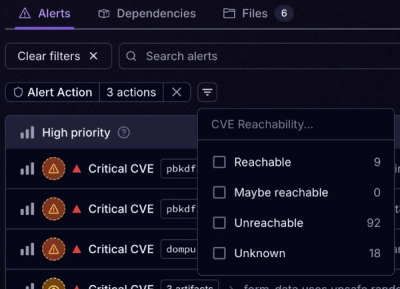
Product
Announcing Socket Fix 2.0
Socket Fix 2.0 brings targeted CVE remediation, smarter upgrade planning, and broader ecosystem support to help developers get to zero alerts.
Web3 Data Made Simple. Powerful APIs for accessing human-readable blockchain data at scale: from blocks and transactions to NFTs and tokens.

A modern python wrapper for the Transpose API Suite.
To obtain a free Transpose API key, sign up on our website. Free tier keys have a rate limit of 1 request per second and 250,000 credits per month. If you need higher rate limits for your project or business, don't hesitate to reach out on our Discord or upgrade your tier directly in the webapp!
Join our Discord to ask technical questions, share what you're building, and chat with others in the community.
Python 3.8 or higher is recommended
To install the python SDK, you can run the following command:
python3 -m pip install -U transpose-data
You can find specific documentation on a per-product basis below.
| Product | Description | Documentation |
|---|---|---|
| Block API | The Block API provides endpoints for accessing low-level blockchain data at scale, including accounts, blocks, transactions, internal transactions, and logs. | Block API Docs |
| ENS API | The ENS API provides endpoints for looking up ENS names (both historical and primary), resolving ENS names and records, and monitoring ENS transfers and sales. | ENS API Docs |
| NFT API | The NFT API provides endpoints for retrieving any collection and NFT in existence, as well as NFT images, operators, owners, transfers, approvals, and much more (fully supports both ERC-721 and ERC-1155 NFTs). | NFT API Docs |
| Token API | The Token API provides endpoints for retrieving any token, token balance, transfer, and symbol in existence, including full support for native token transfers and balances (fully supports both ERC-20 and ERC-777 tokens). | Token API Docs |
| SQL API | The SQL API provides direct SQL access to our entire ecosystem of indexed blockchain data. Paired with our robust indexing pipeline, SQL access gives unlimited flexibility in how you mix, aggregate, and query activity across the blockchain. | SQL API Docs |
| Endpoint API | The Endpoint API provides customized REST endpoints that you can create, version, and use directly in your production applications. | Endpoint API Docs |
You can learn more about the Transpose SDK and how it works below.
Converts a list of strings into a single string, separated by a delimiter.
from transpose.src.util.format import stringify_list
stringify_list(['a', 'b', 'c'], ',')
>>> 'a,b,c'
The Transpose SDK uses custom classes to represent API responses:
TransposeBadRequest
TransposeRateLimit
TransposeInvalidAPIKey
TransposeInternalServerError
TransposeResourceNotFound
These errors will be raised when the SDK encounters an error from the Transpose API.
The SDK will always return a list of response objects from the Transpose API. For example, calling the ens.records_by_date endpoint will return a list of ENSRecord objects.
These response objects can be accessed in the following ways:
ENSRecord[0].ens_name will return the first record's ens_name.ENSRecord[i].ens_name retrieves the ens_name from the i-th responseAll response objects can also be accessed as a dictionary by calling .to_dict() on them:
ENSRecord[0].to_dict() will return the first record as a dictionary.ENSRecord[i].to_dict() retrieves the i-th record as a dictionary.The Transpose SDK can be configured to your liking, allowing you to change the default behavior of the SDK.
If you want to change the chain ID of your query, you can do so by setting the chain_id or chain properties of the Transpose object. For example, if you want to query the Ethereum mainnet, you can do so by running the following code:
from transpose import Transpose
api = Transpose(api_key="YOUR_API_KEY", chain_id=1)
or
from transpose import Transpose
api = Transpose(api_key="YOUR_API_KEY", chain_id="ethereum")
if you wish to change the chain ID of an existing Transpose object, you can do so by running the following code:
api.set_chain("ethereum")
or
api.set_chain(1)
| Chain ID | Chain Name |
|---|---|
| 1 | Ethereum |
| 137 | Polygon |
Response classes are considered deprecated as of v3.1.0 and will be removed in v4.0.0. JSON responses will become standard in v4.0.0
from transpose_sdk import Transpose
api = Transpose(api_key="YOUR_API_KEY", json=True)
Transpose endpoints will return a maximum of 500 results in a single query. To return the next page, simply call api.next(). If api.next() returns None, then there are no more pages.
Here is a standard pagination implementation:
while True:
data = api.next()
# sleep to avoid rate limits
time.sleep(1)
# if there are no more pages, exit loop
if data is None: break
# otherwise, print length of data
else: print(len(data))
api.bulk_request(endpoint_response, requests_per_second, results_to_fetch)
| Parameter | Required | Description | Type |
|---|---|---|---|
| endpoint_response | Yes | The called API function, which returns a list of data models. | List |
| requests_per_second | No | The number of requests per second to make | int |
| results_to_fetch | No | The number of results to fetch | int |
| Code | Title | Model |
|---|---|---|
| 200 | Success | Data Model |
| 400 | Bad Request | Error |
| 401 | Unauthorized | Error |
| 403 | Forbidden | Error |
| 404 | Not Found | Error |
| 500 | Internal Server Error | Error |
Here is an example of how to use bulk_request:
recent_blocks_since = api.bulk_request(api.block.blocks_by_date(added_after='2022-01-01 00:00:00', limit=500))
print(len(recent_blocks_since))
>>> 500
The following methods are available as extras to the Transpose SDK.
You can import extras to your project by using:
from transpose.extras import <MODULE>
Some extras will require additional dependencies to be installed. If you are missing dependencies, the SDK will throw a TransposeDependencyError when you try to import the extra. This error will tell you what dependencies are missing, and give you the exact command to install them:
transpose.src.util.errors.TransposeDependencyError: Missing Dependencies. You can install these via `pip install plotly kaleido`
The SDK natively includes a plotting library which implements plotly. Using it, you can quickly create plots of data obtained through the Transpose API.
For a plotting example, check out the demo file, which will graph the past hour's gas prices in a bar chart.

You'll first need to install the plotting dependencies using:
pip install plotly kaleido
Instantiating a new plot is as simple as importing the Plot class and instantiating it:
from transpose.extras import Plot
chart = Plot(title="Hourly Gas Prices on Ethereum")
This will return an object on which you can call the following methods:
Plot.plotly()
Plot.show()
Plot.render(path, format)
path -> The path to render the plot to.format -> The format to render the plot as. Can be either png, html, jpg, etc.Plot.add_data(data, type, shape, smoothing)
data -> The data to add to the plot. Takes the following format:
{
"x": [], // List of data
"y": [], // List of data
"y_axis": "Gas Price (Gwei)", // OPTIONAL: The name of the y-axis
"x_axis": "Time", // OPTIONAL: The name of the x-axis
}
type -> OPTIONAL: The method used to render the data to the plot. Can be either line or bar.
shape -> OPTIONAL: The shape of the line. Can be either linear, spline, vh, hv, vhv, or hvh.
smoothing -> OPTIONAL: The number of points to smooth the data with.
line, this will calculate a moving average of the data with a period of smoothing.bar, this will group and average the data over smoothing points.To get started and make your first request, make a new Transpose object:
from transpose import Transpose
api = Transpose('transpose_api_key')
From there, you can call endpoints from the api.nft, api.ens, api.token, and api.block subclasses.
You can view the raw HTTP requests the SDK is making by setting the debug flag to True when creating a new Transpose object. For example:
from transpose import Transpose
api = Transpose('transpose_api_key', debug=True)
To show just how powerful our data is, let's get the last ENS domain that expired. All we need is one API call.
from transpose import Transpose
api = Transpose('transpose_api_key')
# get the most recently expired ENS domain
last_expired = api.ens.records_by_date(type='expiration', order='desc', limit=1)
This returns a list of ENS Records, which includes data which you wouldn't be able to easily get from the ENS protocol.
[
{
"ens_name":"game-master-dit-gm.eth",
"ens_node":"9BFFC8C1EDE1E51E4BAE137FA37A81CC0379FC08123C4AA00A931D0D983956B7",
"contract_address":"0x57f1887a8BF19b14fC0dF6Fd9B2acc9Af147eA85",
"token_id":75929000750162030430773866845127925090084516346841580577625168871716954805188,
"meta_block_number":407909,
"owner":"0x2aC92629c4E0E5e4868588f87DC4356606a590b6",
"resolver":"0x4976fb03C32e5B8cfe2b6cCB31c09Ba78EBaBa41",
"resolved_address":"0x2aC92629c4E0E5e4868588f87DC4356606a590b6",
"registration_timestamp":"2022-01-01T05:00:36Z",
"expiration_timestamp":"2049-12-31T23:58:12Z",
"grace_period_ends":"2050-03-31T23:58:12Z",
"premium_period_ends":"2050-04-21T23:58:12Z",
"in_grace_period":false,
"in_premium_period":false,
"is_expired":false,
"last_refreshed":"2022-06-01T09:51:23Z"
}
]
FAQs
Web3 Data Made Simple. Powerful APIs for accessing human-readable blockchain data at scale: from blocks and transactions to NFTs and tokens.
We found that transpose-data demonstrated a healthy version release cadence and project activity because the last version was released less than a year ago. It has 2 open source maintainers collaborating on the project.
Did you know?

Socket for GitHub automatically highlights issues in each pull request and monitors the health of all your open source dependencies. Discover the contents of your packages and block harmful activity before you install or update your dependencies.

Product
Socket Fix 2.0 brings targeted CVE remediation, smarter upgrade planning, and broader ecosystem support to help developers get to zero alerts.

Security News
Socket CEO Feross Aboukhadijeh joins Risky Business Weekly to unpack recent npm phishing attacks, their limited impact, and the risks if attackers get smarter.

Product
Socket’s new Tier 1 Reachability filters out up to 80% of irrelevant CVEs, so security teams can focus on the vulnerabilities that matter.